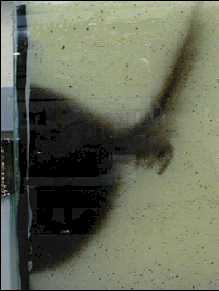|
|
 |
BERKELEY, CA — Researchers at the
U.S. Department of Energy's Lawrence Berkeley National Laboratory have demonstrated that
liquids known as ferrofluids, in response to magnetic fields, can flow in any direction
through soils of different permeability to assume predetermined, uniformly distributed
shapes. Ferrofluids are colloidal suspensions of nanoscale magnetic particles in a
carrier fluid; the particles form magnetic domains separated by coats of dispersant only a
molecule thick. These magnetic fluids have been used in many ways—to form airtight
seals around rapidly moving parts, to move drugs in the bloodstream and rocket propellants
in spacecraft, even to cool and dampen powerful audio speakers. Now steerable ferrofluids
may give rise to new tools for subsurface environmental engineering and laboratory safety.
 |
 FERROFLUID FLOWS THROUGH WATER-SATURATED SAND
TOWARD THE MAGNET AT LEFT. TRAPPED BY THE MAGNETIC FIELD, THE FERROFLUID DEFIES
GRAVITY AND ACCUMULATES SYMMETRICALLY AGAINST THE WALL, WITHOUT EVER REACHING THE BOTTOM.
|
"This is a way of controlling the movement of fluids underground without direct
physical contact," says George Moridis of Berkeley Lab's Earth Sciences Division, who
has investigated ferrofluids with his colleagues Curtis Oldenburg and Sharon Borglin of
ESD's Department of Hydrogeology and Reservoir Dynamics. "In theory, the carrier can
be anything—plain water, or chemicals for waste treatment, or liquids that can
solidify into impermeable barriers, such as polyurethane."
Moridis notes that "we often use injected fluids in environmental clean-up, but
injection is a diffusive process—you pump it in and hope it goes where you
want." Ferrofluid barriers, by contrast, could seal leaking waste tanks, pipes, or
landfills with maximum confidence and minimum environmental disturbance. Injected
ferrofluids could be steered into place beneath contaminated sites by surrounding magnets,
forming an evenly distributed seal.
In addition to their hands-off controllability, Oldenburg adds that "ferrofluids
have strong magnetic signatures, so they can function as imagable tracers," allowing
above-ground sensors to construct images of underground features and fluid flows that are
impractical to visualize by other means.
Each particle in a ferrofluid behaves like a tiny permanent magnet with north and south
poles; these point randomly until an external magnetic field causes them to line up. A
strong field can cause the domains in an open pool of ferrofluid to climb right up the
field lines, resembling a bristling liquid hedgehog.
If a field is stronger in one direction than another, the ferrofluid responds as a
continuous fluid magnet. The strength of attraction depends on the strength of the
magnetic field and on the magnetization of the fluid, which can vary according to the
nature of the suspended magnetic material and how much of it is packed into the carrier.
Movement in a porous medium can also be affected by the pore size of the medium, the
viscosity of the ferrofluid, and other liquids that may be present.
Borglin, Moridis, and Oldenburg demonstrated flow and static holding processes of
ferrofluids in sandy porous media. Using permanent magnets, ferrofluids of different
magnetic properties were drawn through laboratory apparatus that included horizontal and
vertical test beds of different sands under different conditions.
The magnets created predictable pressure gradients in the ferrofluids, causing them to
flow. Close to the magnets, forces outpulled gravity. Final configurations could be
predicted, and were controlled only by magnetic fields—not by injection shape, flow
path, or permeability of the porous medium. Finally, the sand did little to filter out
magnetic particles or reduce magnetic attraction.
"The long-term focus of our research is to maneuver subsurface liquids in the
field," Moridis says, "but it has immediate utility for environmental
researchers and others in laboratory situations, where these techniques can manipulate
fluids such as corrosives or toxics without pumping or direct contact."
Moridis and Oldenburg have applied for a patent on the guidance, containment,
treatment, and imaging of below-ground substances using ferrofluids. Recent work by
Borglin, Moridis, and Oldenburg is reported in a forthcoming issue of Transport in
Porous Media.
The Berkeley Lab is a U.S. Department of Energy national laboratory located in
Berkeley, California. It conducts unclassified scientific research and is managed by the
University of California. |

